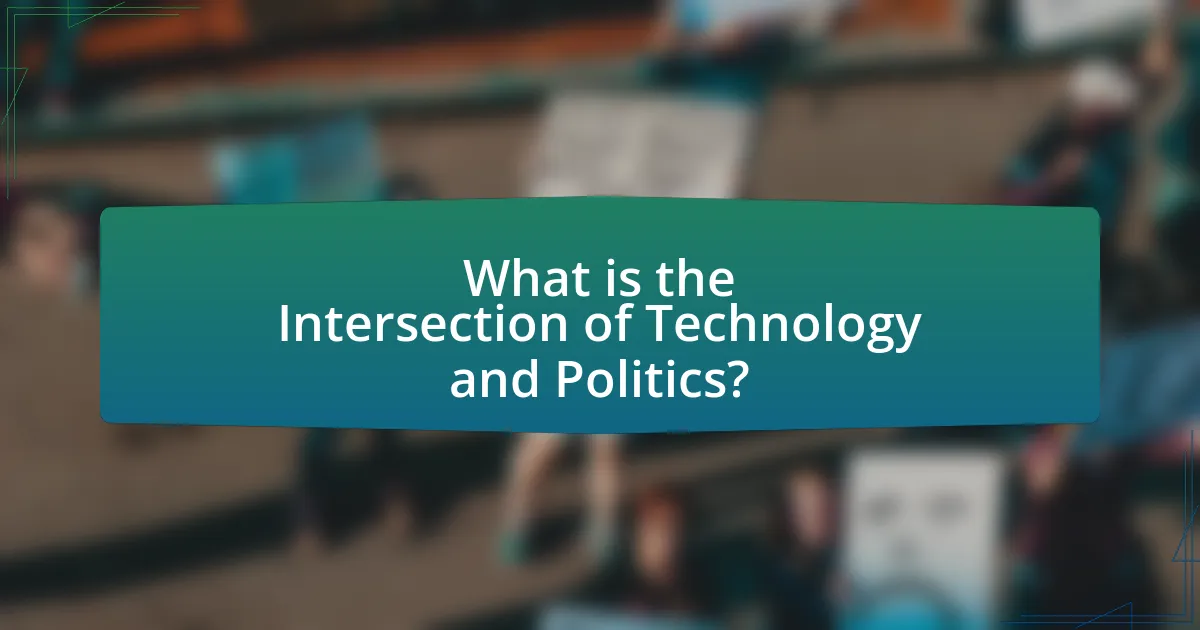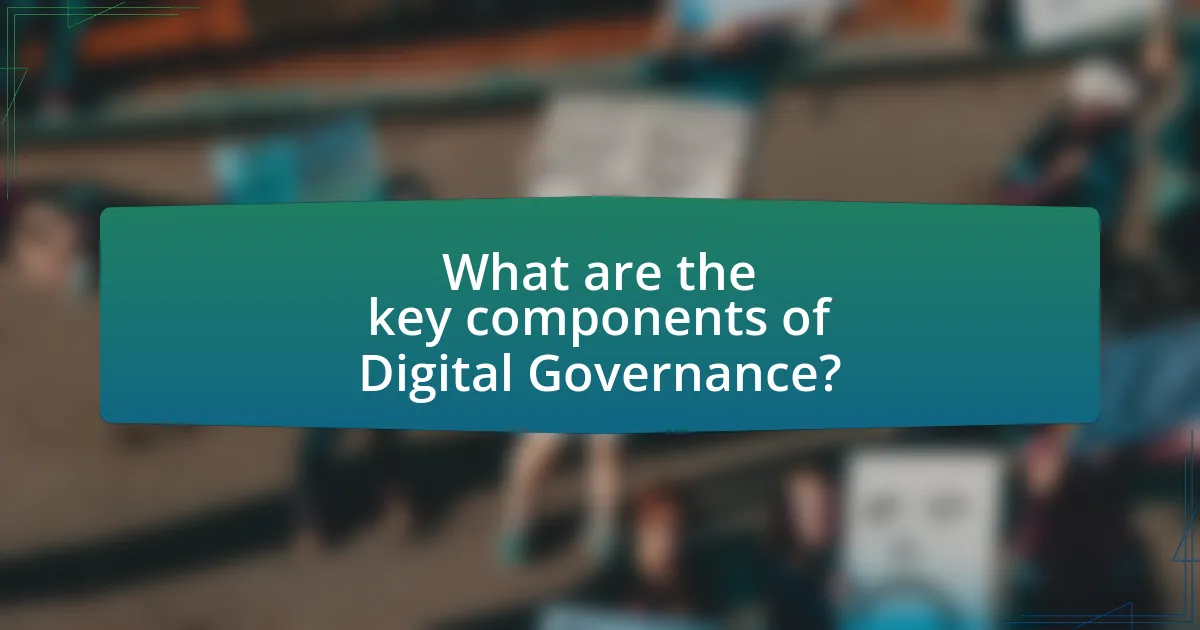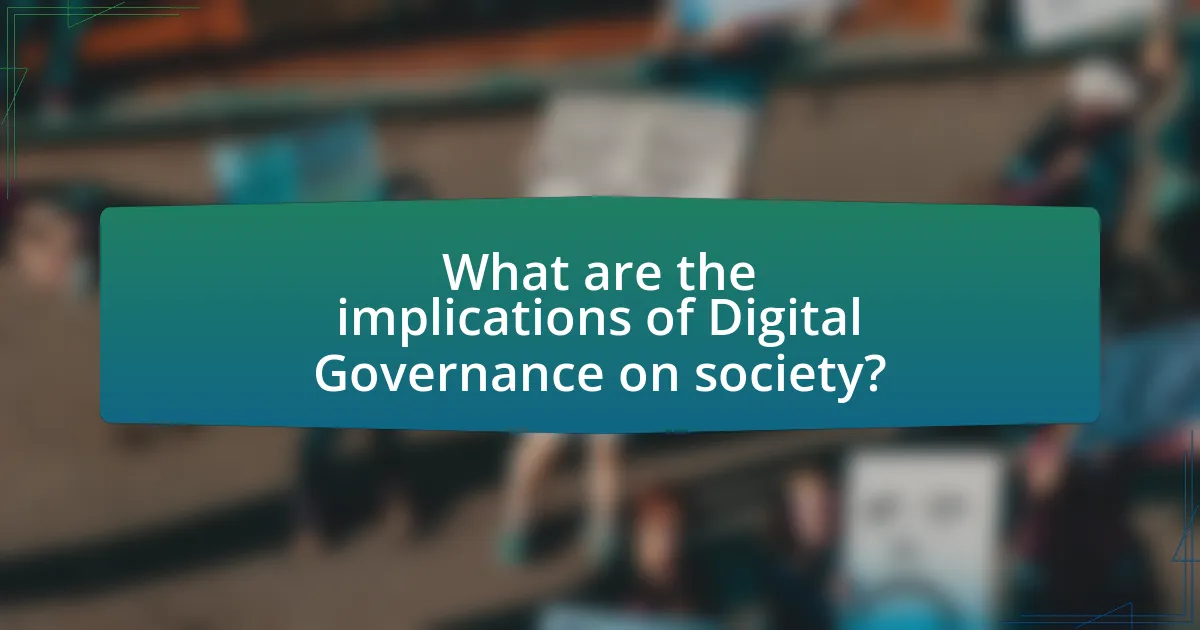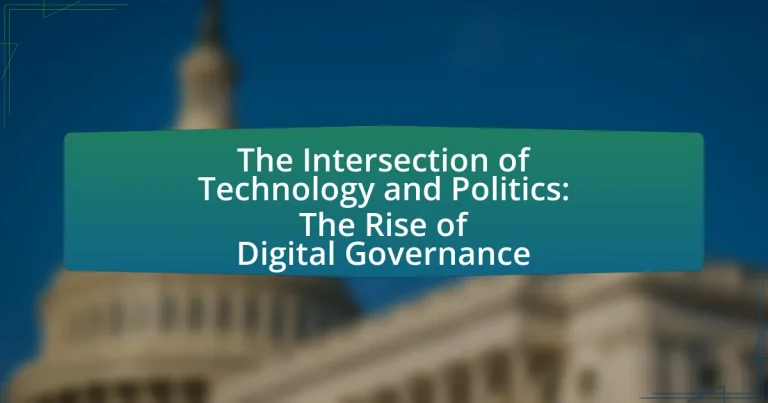The article examines the intersection of technology and politics, specifically focusing on the rise of digital governance. It outlines how technological advancements, such as artificial intelligence, blockchain, and big data analytics, are reshaping political processes, enhancing transparency, and improving citizen engagement. Key components of digital governance, including policy frameworks and stakeholder engagement, are discussed alongside the challenges faced by traditional governance systems. The article also highlights the implications of digital governance on public policy formulation, social equity, and citizen trust, while addressing potential risks and future trends in governance.

What is the Intersection of Technology and Politics?
The intersection of technology and politics refers to the ways in which technological advancements influence political processes, governance, and public policy. This relationship is evident in the rise of digital governance, where governments utilize technology to enhance transparency, improve citizen engagement, and streamline administrative functions. For instance, the implementation of e-governance platforms has enabled citizens to access government services online, thereby increasing efficiency and reducing bureaucratic delays. Additionally, social media platforms have transformed political communication, allowing for real-time engagement between politicians and constituents, as seen in various electoral campaigns worldwide. This dynamic interplay shapes policy decisions and public opinion, highlighting the critical role technology plays in modern governance.
How has technology influenced political processes?
Technology has significantly influenced political processes by enhancing communication, increasing transparency, and enabling data-driven decision-making. The rise of social media platforms, for instance, has transformed how politicians engage with constituents, allowing for real-time interaction and feedback. According to a Pew Research Center study, 69% of Americans use social media, which has become a vital tool for political campaigns and grassroots movements. Additionally, technology facilitates greater transparency through open data initiatives, where governments publish data online, enabling citizens to hold officials accountable. The use of big data analytics in political campaigns allows for targeted messaging, improving voter outreach and engagement. These advancements illustrate how technology reshapes political landscapes, making processes more accessible and participatory.
What are the key technologies shaping modern governance?
Key technologies shaping modern governance include artificial intelligence, blockchain, big data analytics, and cloud computing. Artificial intelligence enhances decision-making processes by analyzing vast amounts of data, enabling governments to respond more effectively to citizen needs. Blockchain technology provides transparency and security in transactions, which is crucial for maintaining public trust in governance. Big data analytics allows for the collection and analysis of large datasets, facilitating informed policy-making and resource allocation. Cloud computing offers scalable infrastructure for government services, improving accessibility and efficiency. These technologies collectively transform how governments operate, engage with citizens, and deliver services.
How do these technologies impact citizen engagement?
Technologies significantly enhance citizen engagement by facilitating direct communication between governments and the public. Digital platforms, such as social media and mobile applications, allow citizens to voice their opinions, access information, and participate in decision-making processes more easily. For instance, a study by the Pew Research Center found that 69% of adults in the U.S. use social media, which serves as a vital tool for civic engagement and mobilization. Furthermore, e-governance initiatives enable citizens to interact with government services online, increasing transparency and accountability. This shift towards digital governance fosters a more informed and active citizenry, ultimately leading to improved democratic participation.
Why is digital governance becoming essential?
Digital governance is becoming essential due to the increasing reliance on technology in public administration and the need for transparency, accountability, and efficiency in government operations. As governments adopt digital tools to enhance service delivery, they face challenges related to data privacy, cybersecurity, and citizen engagement. For instance, a report by the United Nations in 2020 highlighted that 90% of countries have implemented some form of e-government services, emphasizing the necessity for robust digital governance frameworks to manage these systems effectively. This trend underscores the importance of establishing clear policies and regulations to ensure that digital initiatives align with democratic values and public interests.
What challenges does traditional governance face?
Traditional governance faces significant challenges including bureaucratic inefficiency, lack of transparency, and resistance to change. Bureaucratic inefficiency often results in slow decision-making processes, hindering timely responses to societal needs. Lack of transparency can erode public trust, as citizens may feel disconnected from governmental processes. Additionally, resistance to change is prevalent as traditional governance structures struggle to adapt to the rapid advancements in technology and the expectations of a digitally engaged populace. These challenges are exacerbated by the increasing demand for accountability and responsiveness in governance, which traditional systems may not adequately address.
How does digital governance address these challenges?
Digital governance addresses challenges by leveraging technology to enhance transparency, efficiency, and citizen engagement in public administration. It utilizes digital tools and platforms to streamline processes, reduce bureaucratic inefficiencies, and improve access to government services. For instance, the implementation of e-governance systems has been shown to decrease processing times for permits and licenses, as evidenced by a World Bank report indicating that countries with robust digital governance frameworks can reduce service delivery times by up to 50%. Additionally, digital governance fosters greater accountability through data transparency, allowing citizens to monitor government actions and expenditures, which can lead to reduced corruption.

What are the key components of Digital Governance?
The key components of Digital Governance include policy frameworks, digital infrastructure, data management, stakeholder engagement, and regulatory compliance. Policy frameworks establish guidelines for digital initiatives, ensuring alignment with governmental objectives. Digital infrastructure encompasses the technology and systems necessary for implementing digital services. Data management focuses on the collection, storage, and analysis of data to inform decision-making and improve service delivery. Stakeholder engagement involves collaboration with citizens, businesses, and other entities to foster transparency and inclusivity. Regulatory compliance ensures adherence to laws and standards governing digital practices, safeguarding privacy and security. These components collectively enable effective governance in a digital context, as evidenced by various government initiatives that have successfully integrated technology into public administration.
What technologies are integral to digital governance?
Technologies integral to digital governance include cloud computing, big data analytics, artificial intelligence, blockchain, and the Internet of Things (IoT). Cloud computing enables scalable storage and processing of government data, facilitating efficient service delivery. Big data analytics allows for the analysis of vast amounts of information to inform policy decisions and improve public services. Artificial intelligence enhances decision-making processes through predictive analytics and automation. Blockchain technology ensures transparency and security in transactions and record-keeping, while IoT devices collect real-time data to improve urban management and public safety. These technologies collectively enhance the efficiency, transparency, and responsiveness of government operations.
How do data analytics enhance decision-making in governance?
Data analytics enhances decision-making in governance by providing actionable insights derived from large datasets, enabling policymakers to make informed choices. For instance, data analytics can identify trends in public health, allowing governments to allocate resources effectively during crises, such as the COVID-19 pandemic, where data-driven decisions were crucial in managing healthcare responses. Additionally, analytics can improve transparency and accountability by tracking government spending and service delivery, as evidenced by initiatives like open data platforms that allow citizens to access information and engage with their governments. This evidence-based approach leads to more effective policies and improved public trust in governance.
What role does artificial intelligence play in public administration?
Artificial intelligence plays a transformative role in public administration by enhancing decision-making processes, improving service delivery, and increasing operational efficiency. AI technologies, such as machine learning and data analytics, enable government agencies to analyze vast amounts of data, leading to more informed policy decisions and resource allocation. For instance, AI-driven predictive analytics can forecast public service demands, allowing for proactive measures in areas like healthcare and transportation. Additionally, AI chatbots and virtual assistants streamline citizen interactions, providing timely responses and reducing administrative burdens. The implementation of AI in public administration has been shown to reduce costs and improve service quality, as evidenced by various case studies, including the use of AI in tax collection and fraud detection, which has led to significant revenue increases for governments.
How does digital governance improve transparency and accountability?
Digital governance improves transparency and accountability by utilizing technology to enhance access to information and streamline processes. By implementing digital platforms, governments can provide real-time data on public spending, policy decisions, and service delivery, allowing citizens to monitor government actions more effectively. For instance, the use of open data initiatives enables the public to access government datasets, fostering an environment where citizens can scrutinize and hold officials accountable for their actions. Research by the World Bank indicates that countries with higher levels of digital governance report increased citizen trust and engagement, demonstrating a direct correlation between technology use and improved governance outcomes.
What mechanisms are in place to ensure data security and privacy?
Data security and privacy are ensured through mechanisms such as encryption, access controls, and compliance with regulations. Encryption protects data by converting it into a secure format that can only be read by authorized users, making it difficult for unauthorized parties to access sensitive information. Access controls limit who can view or manipulate data, ensuring that only individuals with the necessary permissions can interact with it. Compliance with regulations, such as the General Data Protection Regulation (GDPR) in Europe, mandates organizations to implement strict data protection measures and provides legal frameworks for safeguarding personal information. These mechanisms collectively enhance the security and privacy of data in the context of digital governance.
How can citizens participate in digital governance initiatives?
Citizens can participate in digital governance initiatives by engaging in online platforms that facilitate public consultation and feedback on government policies. These platforms, such as e-participation websites and social media channels, allow citizens to voice their opinions, contribute ideas, and collaborate with government officials. For example, the European Union’s “Your Voice in Europe” initiative enables citizens to share their views on legislative proposals, demonstrating how digital tools can enhance civic engagement. Additionally, citizens can participate in digital governance through voting in online polls or surveys, which help shape policy decisions based on public sentiment.

What are the implications of Digital Governance on society?
Digital governance significantly impacts society by enhancing transparency, efficiency, and citizen engagement in governmental processes. It allows for real-time access to information, which fosters accountability among public officials and institutions. For instance, the implementation of e-governance platforms has been shown to reduce corruption levels, as evidenced by a study from the World Bank, which found that countries with higher digital governance scores experienced a 20% decrease in corruption perceptions. Additionally, digital governance facilitates improved service delivery, as seen in Estonia, where digital identity systems streamline access to government services, resulting in a 30% reduction in administrative costs. Overall, the implications of digital governance on society include increased trust in government, better resource allocation, and enhanced civic participation.
How does digital governance affect public policy formulation?
Digital governance significantly influences public policy formulation by enhancing transparency, efficiency, and citizen engagement. It allows governments to utilize digital tools and platforms to gather data, analyze public needs, and streamline decision-making processes. For instance, the implementation of e-governance initiatives has led to improved access to information, enabling policymakers to make informed decisions based on real-time data and public feedback. Research by the United Nations E-Government Survey indicates that countries with advanced digital governance frameworks experience higher levels of citizen satisfaction and trust in government, which directly impacts the effectiveness of public policies.
What are the potential risks of relying on technology in governance?
Relying on technology in governance poses several potential risks, including cybersecurity threats, data privacy concerns, and the risk of exacerbating inequality. Cybersecurity threats can lead to data breaches and unauthorized access to sensitive government information, as evidenced by incidents like the 2020 SolarWinds hack, which compromised numerous U.S. government agencies. Data privacy concerns arise from the collection and storage of personal information, which can be misused or inadequately protected, as highlighted by the Cambridge Analytica scandal that exposed vulnerabilities in data handling practices. Additionally, reliance on technology can exacerbate inequality, as marginalized communities may lack access to digital tools and infrastructure, leading to unequal participation in governance processes.
How can digital governance promote social equity?
Digital governance can promote social equity by ensuring equal access to government services and information through technology. By implementing online platforms and digital tools, governments can reduce barriers for marginalized communities, facilitating participation in decision-making processes. For instance, the use of e-governance initiatives has been shown to improve service delivery and transparency, which can lead to increased trust and engagement among citizens. Research indicates that countries with robust digital governance frameworks, such as Estonia, have successfully enhanced social equity by providing universal access to digital services, thereby empowering all citizens regardless of their socio-economic status.
What best practices should be adopted for effective digital governance?
Effective digital governance requires the adoption of best practices such as establishing clear policies, ensuring transparency, and fostering stakeholder engagement. Clear policies provide a framework for decision-making and accountability, which is essential for maintaining trust in digital systems. Transparency in processes and data usage allows citizens to understand how their information is managed, thereby enhancing public confidence. Additionally, engaging stakeholders, including citizens and organizations, in the governance process ensures that diverse perspectives are considered, leading to more inclusive and effective outcomes. These practices are supported by research indicating that transparency and stakeholder involvement significantly improve governance effectiveness and public trust in digital initiatives.
How can governments ensure inclusivity in digital platforms?
Governments can ensure inclusivity in digital platforms by implementing policies that promote accessibility, affordability, and user-friendly design. For instance, legislation can mandate that all digital services comply with accessibility standards, such as the Web Content Accessibility Guidelines (WCAG), which provide a framework for making web content more accessible to people with disabilities. Additionally, governments can subsidize internet access for low-income populations, as seen in programs like the Federal Communications Commission’s Lifeline program in the United States, which provides discounts on phone and internet services to eligible low-income consumers. By prioritizing these measures, governments can create a more equitable digital environment that serves diverse populations effectively.
What strategies can enhance citizen trust in digital governance?
To enhance citizen trust in digital governance, transparency and accountability are essential strategies. Implementing open data initiatives allows citizens to access government information, fostering a sense of involvement and oversight. For instance, the U.S. government’s Data.gov platform provides public access to a wealth of datasets, which has been shown to improve public perception of government transparency. Additionally, establishing clear channels for citizen feedback and participation in decision-making processes can further build trust. Research indicates that when citizens feel their voices are heard, their trust in government increases significantly. For example, the OECD found that participatory budgeting initiatives lead to higher levels of trust in local governments. Lastly, ensuring robust cybersecurity measures protects citizens’ data, which is crucial for maintaining trust in digital platforms. A report by the Ponemon Institute highlights that 70% of consumers are more likely to trust organizations that demonstrate strong data protection practices.
What are the future trends in Digital Governance?
Future trends in digital governance include increased use of artificial intelligence for decision-making, enhanced citizen engagement through digital platforms, and a focus on data privacy and security. Artificial intelligence is being integrated into public services to improve efficiency and responsiveness, as seen in smart city initiatives where data analytics optimize resource allocation. Digital platforms are facilitating greater citizen participation in governance, exemplified by online consultations and e-petitions that allow for real-time feedback on policy decisions. Additionally, as governments adopt more digital solutions, there is a growing emphasis on robust data protection regulations to safeguard personal information, reflecting global trends such as the General Data Protection Regulation (GDPR) in Europe. These trends indicate a shift towards more transparent, efficient, and citizen-centric governance models.
How will emerging technologies shape the future of governance?
Emerging technologies will significantly shape the future of governance by enhancing transparency, efficiency, and citizen engagement. Technologies such as blockchain can provide immutable records of government transactions, thereby reducing corruption and increasing public trust. For instance, the use of blockchain in voting systems has been piloted in various jurisdictions, demonstrating its potential to ensure secure and verifiable elections. Additionally, artificial intelligence can streamline bureaucratic processes, allowing for faster decision-making and resource allocation. A study by the McKinsey Global Institute found that AI could improve government productivity by up to 20%, indicating a substantial impact on operational efficiency. Furthermore, digital platforms enable greater citizen participation in governance, as seen in initiatives like participatory budgeting, where citizens directly influence budget allocations. These advancements illustrate how emerging technologies are poised to transform governance into a more transparent, efficient, and participatory system.
What role will public-private partnerships play in advancing digital governance?
Public-private partnerships (PPPs) will play a crucial role in advancing digital governance by facilitating collaboration between government entities and private sector organizations to enhance service delivery and innovation. These partnerships enable the pooling of resources, expertise, and technology, which can lead to more efficient and effective digital solutions for public services. For instance, the World Economic Forum has highlighted successful PPPs in various countries that have improved digital infrastructure, such as Estonia’s e-government initiatives, which leverage private sector technology to streamline government processes. By combining the agility and innovation of the private sector with the regulatory framework and public accountability of the government, PPPs can drive the development of robust digital governance frameworks that are responsive to citizens’ needs.
What practical steps can governments take to implement digital governance effectively?
Governments can implement digital governance effectively by establishing clear policies and frameworks that promote transparency, accessibility, and accountability in digital services. This includes creating a comprehensive digital strategy that aligns with national priorities, investing in digital infrastructure to ensure reliable internet access, and providing training for public servants to enhance digital skills.
For instance, the European Union’s Digital Single Market strategy aims to remove barriers to online services and ensure that citizens can access digital services seamlessly across member states. Additionally, governments should engage with citizens through participatory platforms to gather feedback and improve services, as seen in initiatives like the U.S. Digital.gov, which focuses on user-centered design.
These steps are supported by research indicating that effective digital governance leads to increased citizen trust and participation, as evidenced by the World Bank’s findings on e-government initiatives improving service delivery and citizen engagement.




